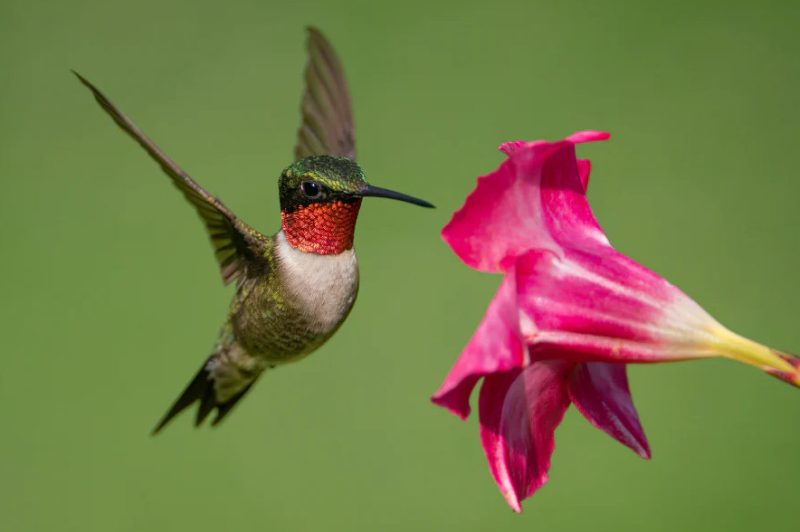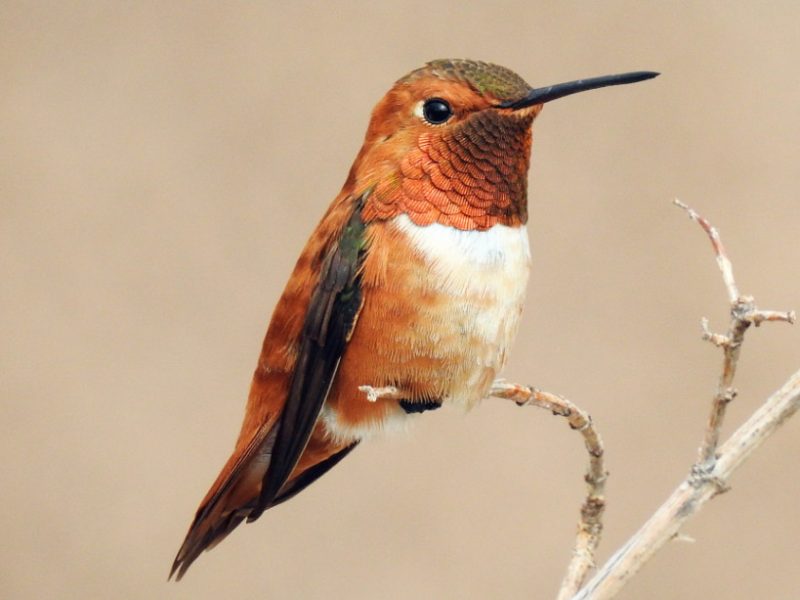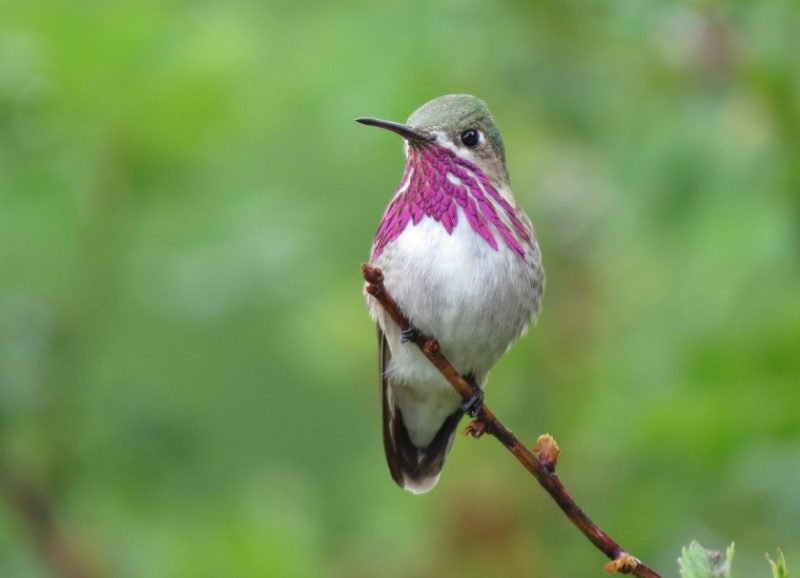A warm Missouri morning often brings the gentle hum of tiny wings near blooming gardens and feeders. Among the blossoms, flashes of green and ruby glide through the air, revealing the presence of hummingbirds. These delicate birds, admired for their shimmering feathers and incredible speed, capture the attention of anyone who pauses to watch.
Missouri provides both a home for breeding hummingbirds and a temporary stop for migrating species. One species stays through the summer, while others appear briefly during their seasonal journeys. Each encounter offers a unique chance to observe the beauty and diversity of these small yet remarkable birds.
Here are the four hummingbird species known to visit Missouri, along with identification details and photographs to help you recognize them more easily.
Different Types of Hummingbirds Found in Missouri
Ruby-throated Hummingbird (Archilochus colubris)

The Ruby-throated Hummingbird is the most common and widespread hummingbird in Missouri, and the only species that breeds in the state. It is a tiny bird, measuring about 3 to 3.5 inches long, with a wingspan of around 4 inches and a weight of just over 3 grams. Despite its small size, it is remarkably strong and fast, capable of beating its wings up to 50 times per second and hovering gracefully in midair as it feeds.
Males are instantly recognizable by their iridescent ruby-red throat, known as a gorget, which glows brilliantly when hit by sunlight. The rest of their plumage is metallic green on the back and crown, with a pale grayish-white underside. Females lack the red throat, instead showing a white throat with faint gray spots and a more rounded tail marked with white tips. Both sexes have long, thin bills perfectly adapted for sipping nectar from deep, tubular flowers.
In Missouri, Ruby-throated Hummingbirds arrive in late April or early May and remain until late September or early October. They are most active during the summer months, frequenting gardens, forest edges, and meadows where nectar-rich flowers are abundant. Home gardens with brightly colored blooms or feeders filled with sugar water quickly become favorite feeding spots for these energetic birds.
Their behavior is lively and territorial, especially among males during the breeding season. Males perform impressive courtship displays, flying in U-shaped arcs to attract females. Once nesting begins, females take full responsibility for building the tiny cup-shaped nest, usually placed on a slender branch or sheltered fork. The nest, made of plant down and spider silk, is no larger than a ping-pong ball and expands as the chicks grow.
By late summer, Ruby-throated Hummingbirds begin preparing for migration, doubling their body weight in fat to fuel their long journey. Each year, they travel thousands of miles to wintering grounds in Central America, many making the incredible nonstop flight across the Gulf of Mexico. Their annual return to Missouri marks one of the most eagerly anticipated signs of spring for birdwatchers across the state.
Rufous Hummingbird (Selasphorus rufus)

The Rufous Hummingbird is one of the most vibrant and striking visitors to Missouri, appearing only occasionally but leaving a lasting impression. Measuring around 3.5 inches in length and weighing about 3 to 4 grams, it is small yet fiercely spirited. This hummingbird is easily recognized by its glowing orange and copper tones that seem to shimmer in the light, making it one of the most visually distinctive hummingbirds in North America.
Adult males display a brilliant orange back, sides, and tail, along with an iridescent red-orange throat that catches the sunlight with dazzling intensity. Their underparts are pale, and their wings are dark and narrow. Females and immature birds are more subdued in coloration, showing greenish upperparts with a soft rufous wash on the flanks and tail feathers. Despite their size, Rufous Hummingbirds are known for their toughness and endurance, often migrating farther north than any other hummingbird species.
In Missouri, sightings of Rufous Hummingbirds typically occur from late October through early January, particularly around feeding stations that remain active into the cooler months. These birds are known for their bold and aggressive behavior, frequently dominating feeders and driving away even larger hummingbirds. They defend their feeding territories relentlessly, darting and diving with surprising speed and precision.
Their natural breeding range extends from the Pacific Northwest through Alaska, where they nest in forested and shrubby habitats. During migration, they travel thousands of miles to their wintering grounds in Mexico, often taking an inland route through the Rocky Mountains. Some individuals wander much farther east, reaching the central United States, including Missouri, where they are sometimes documented by dedicated birdwatchers.
Rufous Hummingbirds are remarkable for their adaptability and resilience. They can tolerate cooler temperatures better than most hummingbirds, allowing them to survive in Missouri longer into the year than the Ruby-throated species. Spotting one at a backyard feeder during the fall or early winter is an extraordinary experience, offering a glimpse of one of nature’s most determined and brilliantly colored travelers.
Black-chinned Hummingbird (Archilochus alexandri)

The Black-chinned Hummingbird is an uncommon but fascinating visitor to Missouri, appearing only on rare occasions during migration. It measures about 3.25 inches long and weighs around 3 grams, making it similar in size to the Ruby-throated Hummingbird. Despite its subtle coloring, this species stands out once observed closely, revealing delicate iridescence that changes with the light.
Adult males feature a glossy black throat that, when illuminated by sunlight, reveals a narrow, shimmering violet band along the lower edge. Their backs and crowns are metallic green, and their underparts are pale gray to white. Females lack the dark throat, displaying instead a clean white underside and a faintly streaked neck. Their bills are slightly longer and more curved than those of the Ruby-throated Hummingbird, a helpful clue for identification.
In the wild, the Black-chinned Hummingbird breeds throughout the western and southwestern United States, preferring habitats such as arid canyons, desert scrub, and riparian woodlands along rivers and streams. During migration, a few individuals wander eastward, occasionally reaching the central states. In Missouri, sightings tend to occur in August or September, often concentrated in southern areas where migrating birds may stop to feed before continuing south.
Their behavior is agile and cautious. They hover steadily while feeding, darting between flowers or feeders with quick, fluid movements. Males perform looping dives during courtship displays, emitting a faint humming sound created by their tail feathers. Though less aggressive than the Rufous Hummingbird, they can still defend a favored feeding area from rivals.
Black-chinned Hummingbirds winter in Mexico and Central America, undertaking long migratory journeys that reflect their adaptability and endurance. Observing one in Missouri is a rare delight, especially for birders familiar only with the Ruby-throated species. A flash of purple beneath a dark throat is often the first sign that this elegant western traveler has made an unexpected stop in the Midwest.
Calliope Hummingbird (Selasphorus calliope)

The Calliope Hummingbird holds the title of the smallest bird in the United States, measuring only about 3 inches in length and weighing less than 3 grams. Despite its tiny size, it is a hardy and determined traveler, capable of migrating thousands of miles each year between its breeding and wintering grounds. Its presence in Missouri is rare but deeply rewarding for bird enthusiasts lucky enough to spot one during migration.
Adult males are easily recognized by their striking magenta-colored throat feathers, which form narrow streaks radiating outward like a fan. This unique pattern sets them apart from all other North American hummingbirds. Their upperparts are glossy green, and their underparts are pale with a hint of buff on the sides. Females and immature birds lack the vivid throat markings, instead showing a creamy-white underside with cinnamon tones on the flanks and a light green back.
The Calliope Hummingbird breeds in the mountainous regions of the western United States and southern Canada, favoring open meadows, mountain slopes, and forest edges. During migration, it travels all the way to Mexico for the winter, following a remarkable southward route along the Rocky Mountains. A few individuals, however, occasionally stray eastward, reaching the central plains and Midwest. In Missouri, these tiny travelers are sometimes spotted in late fall, particularly at well-maintained backyard feeders.
Although delicate in appearance, the Calliope Hummingbird is astonishingly resilient. It thrives in cooler, high-altitude environments where few other hummingbirds venture, and it can endure surprising temperature drops during migration. Males are territorial and will defend feeding areas fiercely, often chasing away larger species with fearless agility. Their rapid, darting flight and distinctive buzzing sound make them both captivating and challenging to follow.
Spotting a Calliope Hummingbird in Missouri is a rare and special experience. These miniature marvels remind observers of the incredible endurance and adaptability of hummingbirds. For those who leave their feeders up through late autumn, an unexpected visit from this tiny western gem is a moment of pure joy and wonder.
Tips for Attracting Hummingbirds in Missouri
Creating a hummingbird-friendly space in Missouri is both rewarding and simple. These energetic birds are drawn to gardens that provide reliable food sources, safe resting areas, and a clean, inviting environment. With the right combination of plants and care, your yard can become a regular stop for both resident and migrating hummingbirds.
One of the best ways to attract them is by planting native, nectar-rich flowers. Species such as trumpet honeysuckle, bee balm, red columbine, and cardinal flower are especially appealing because of their tubular shapes and bright red or orange hues. These colors naturally catch the attention of hummingbirds searching for energy-rich nectar. Arranging flowers to bloom from spring through early fall ensures a steady food supply throughout the season.
Feeders are another excellent way to bring hummingbirds closer. A simple mixture of one part white sugar to four parts water closely mimics natural nectar. Boil the water to dissolve the sugar, let it cool, and fill your feeders. There’s no need to add red dye, as most feeders already have red parts that attract hummingbirds. Clean feeders thoroughly once or twice a week, and more often during hot weather, to prevent mold and harmful bacteria from forming.
In addition to food, hummingbirds need places to perch and rest between feedings. Small branches, wires, or even thin trellises make perfect perching spots. Providing these resting areas encourages longer visits and allows you to observe their fascinating behaviors up close. A shallow birdbath with gently moving water can also appeal to them, as they occasionally enjoy bathing and drinking from fine mists.
Keeping feeders filled into early fall helps attract migrating hummingbirds such as the Rufous or Calliope species, which may pass through Missouri on their way south. Maintaining a welcoming environment during this time supports these long-distance travelers and increases your chances of witnessing rare hummingbird visitors. With a bit of patience and care, your backyard can become a lively sanctuary for these dazzling little birds.
FAQs About Hummingbirds in Missouri
When do hummingbirds arrive in Missouri?
Most Ruby-throated Hummingbirds arrive in late April, while peak activity occurs in June through August. Migrants may linger until early October.
When should I take down my hummingbird feeders in Missouri?
Leave feeders up until at least mid-October to support late migrants such as Rufous or Calliope Hummingbirds.
What flowers attract hummingbirds the most in Missouri?
Native plants with red, tubular blooms — such as trumpet vine, bee balm, and red columbine — are among their favorites.
Can hummingbirds survive the winter in Missouri?
Ruby-throated Hummingbirds migrate south, but on rare occasions, Rufous Hummingbirds may overwinter if conditions are mild and food is available.






